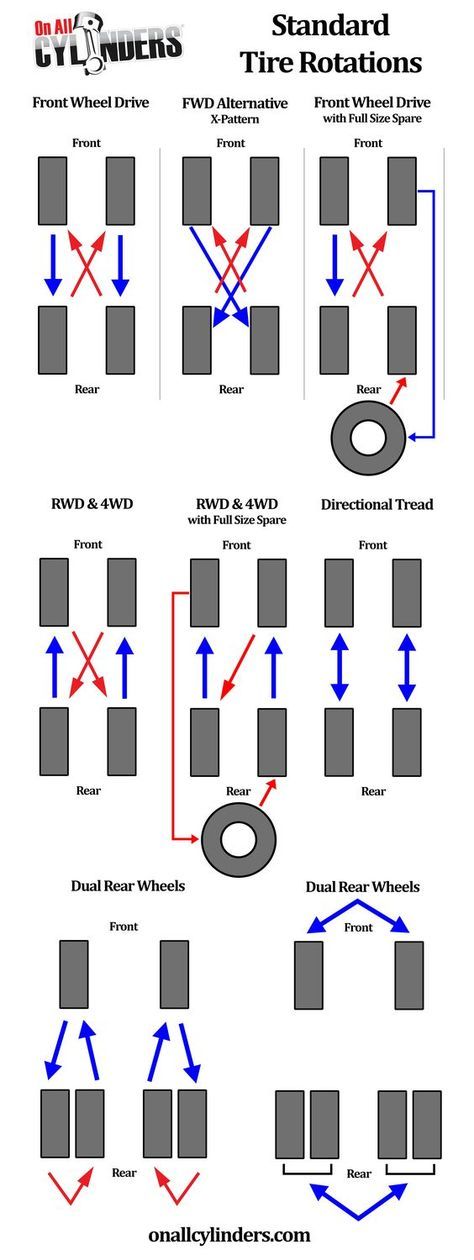Tire rotation, that is routinely repositioning your vehicle’s tires in specific patterns from front to back or side to side, is an important element of tire upkeep and safety. Additionally, rotating your tires may also be required to keep your tires covered under warranty. For a quick visual summary of tire rotation, check out our Tread Life episode about tire rotation. Read on for more information about what tire rotation is, why tire rotation patterns matter, and the correct pattern for your vehicle’s needs.
Find Your Bridgestone Service Center
Tire rotation means periodically changing the position of each of the tires on your vehicle. You should rotate your tires as recommended by the vehicle manufacturer, or every 5,000 miles. For many of you, that will mean when you get your vehicle’s oil changed.
Regularly rotating your tires also gives you a good opportunity to visually inspect them for damage, check their air pressure, have them rebalanced if you’re noticing any vibration, and check their tread depth.
There are several reasons why tire rotation is an important element of your standard tire care. First, by routinely rotating your tires, wear is spread evenly across all four tires, and their tread life is maximized. That’s because each specific position on your vehicle requires a different give from each tire—(for example, tires on the front of a front-wheel drive vehicle will take a larger proportion of the torque and friction that’s needed for turning, accelerating and braking)—and can lead to more, or less, wear on the tire. It is especially important to rotate new tires by 5,000 miles because deep, fresh tire tread is more susceptible to uneven wear.
Secondly, even tread wear keeps the tread depth on your tires uniform, which can help keep traction and handling consistent across all four tires. This will improve cornering and braking performance and keep your vehicle safer for driving overall.
Finally, if your vehicle has all-wheel-drive, evenly worn tires lower the stresses on the drivetrain, reducing wear on expensive drive components.
For those looking for a luxury tire experience
See Tire Details This Tire Fits Your Vehicle See a map of stores near you where you can buy this tire
See Tires That Fit Does Not Fit Your Vehicle
See if it Fits Not Sure If This Tire Fits
80,000 miles of quiet, comfort and control*
See Tire Details This Tire Fits Your Vehicle See a map of stores near you where you can buy this tire
See Tires That Fit Does Not Fit Your Vehicle
See if it Fits Not Sure If This Tire Fits
Keep your life on a roll
See Tire Details This Tire Fits Your Vehicle See a map of stores near you where you can buy this tire
See Tires That Fit Does Not Fit Your Vehicle
See if it Fits Not Sure If This Tire Fits
All-season tires that won't stop until they get you there
See Tire Details This Tire Fits Your Vehicle See a map of stores near you where you can buy this tire
See Tires That Fit Does Not Fit Your Vehicle
See if it Fits Not Sure If This Tire Fits
Confident all-weather protection
See Tire Details This Tire Fits Your Vehicle See a map of stores near you where you can buy this tire
See Tires That Fit Does Not Fit Your Vehicle
See if it Fits Not Sure If This Tire Fits
Drive more and fill up your tank less*
See Tire Details This Tire Fits Your Vehicle See a map of stores near you where you can buy this tire
See Tires That Fit Does Not Fit Your Vehicle
See if it Fits Not Sure If This Tire Fits
Extended mobility PLUS improved performance through the elements
See Tire Details This Tire Fits Your Vehicle See a map of stores near you where you can buy this tire
See Tires That Fit Does Not Fit Your Vehicle
See if it Fits Not Sure If This Tire Fits
Built for your truck, SUV, or CUV
See Tire Details This Tire Fits Your Vehicle See a map of stores near you where you can buy this tire
See Tires That Fit Does Not Fit Your Vehicle
See if it Fits Not Sure If This Tire Fits
Tough enough to take a puncture*
See Tire Details This Tire Fits Your Vehicle See a map of stores near you where you can buy this tire
See Tires That Fit Does Not Fit Your Vehicle
See if it Fits Not Sure If This Tire Fits
Tires that take you on a thrill ride
See Tire Details This Tire Fits Your Vehicle See a map of stores near you where you can buy this tire
See Tires That Fit Does Not Fit Your Vehicle
See if it Fits Not Sure If This Tire Fits
Ready for heavy-duty hauls
See Tire Details This Tire Fits Your Vehicle See a map of stores near you where you can buy this tire
See Tires That Fit Does Not Fit Your Vehicle
See if it Fits Not Sure If This Tire Fits
High performance driving all year long
See Tire Details This Tire Fits Your Vehicle See a map of stores near you where you can buy this tire
See Tires That Fit Does Not Fit Your Vehicle
See if it Fits Not Sure If This Tire Fits
Handle it all in your high performance CUV or SUV
See Tire Details This Tire Fits Your Vehicle See a map of stores near you where you can buy this tire
See Tires That Fit Does Not Fit Your Vehicle
See if it Fits Not Sure If This Tire Fits
Ready for the long haul
See Tire Details This Tire Fits Your Vehicle See a map of stores near you where you can buy this tire
See Tires That Fit Does Not Fit Your Vehicle
See if it Fits Not Sure If This Tire Fits
Built to keep you and your workload going
See Tire Details This Tire Fits Your Vehicle See a map of stores near you where you can buy this tire
See Tires That Fit Does Not Fit Your Vehicle
See if it Fits Not Sure If This Tire Fits
Built for the demands of commercial highway driving
See Tire Details This Tire Fits Your Vehicle See a map of stores near you where you can buy this tire
See Tires That Fit Does Not Fit Your Vehicle
See if it Fits Not Sure If This Tire Fits
View All Season Tires
For those looking for a luxury tire experience
See Tire Details This Tire Fits Your Vehicle See a map of stores near you where you can buy this tire
See Tires That Fit Does Not Fit Your Vehicle
See if it Fits Not Sure If This Tire Fits
Keep your life on a roll
See Tire Details This Tire Fits Your Vehicle See a map of stores near you where you can buy this tire
See Tires That Fit Does Not Fit Your Vehicle
See if it Fits Not Sure If This Tire Fits
Built for your truck, SUV, or CUV
See Tire Details This Tire Fits Your Vehicle See a map of stores near you where you can buy this tire
See Tires That Fit Does Not Fit Your Vehicle
See if it Fits Not Sure If This Tire Fits
Take on the intensity of on and off road driving
See Tire Details This Tire Fits Your Vehicle See a map of stores near you where you can buy this tire
See Tires That Fit Does Not Fit Your Vehicle
See if it Fits Not Sure If This Tire Fits
Tires that take you on a thrill ride
See Tire Details This Tire Fits Your Vehicle See a map of stores near you where you can buy this tire
See Tires That Fit Does Not Fit Your Vehicle
See if it Fits Not Sure If This Tire Fits
Ready for heavy-duty hauls
See Tire Details This Tire Fits Your Vehicle See a map of stores near you where you can buy this tire
See Tires That Fit Does Not Fit Your Vehicle
See if it Fits Not Sure If This Tire Fits
Handle it all in your high performance CUV or SUV
See Tire Details This Tire Fits Your Vehicle See a map of stores near you where you can buy this tire
See Tires That Fit Does Not Fit Your Vehicle
See if it Fits Not Sure If This Tire Fits
Next level summer performance for your Sport Truck or SUV
See Tire Details This Tire Fits Your Vehicle See a map of stores near you where you can buy this tire
See Tires That Fit Does Not Fit Your Vehicle
See if it Fits Not Sure If This Tire Fits
Ready for the long haul
See Tire Details This Tire Fits Your Vehicle See a map of stores near you where you can buy this tire
See Tires That Fit Does Not Fit Your Vehicle
See if it Fits Not Sure If This Tire Fits
Built to keep you and your workload going
See Tire Details This Tire Fits Your Vehicle See a map of stores near you where you can buy this tire
See Tires That Fit Does Not Fit Your Vehicle
See if it Fits Not Sure If This Tire Fits
Built for the demands of commercial highway driving
See Tire Details This Tire Fits Your Vehicle See a map of stores near you where you can buy this tire
See Tires That Fit Does Not Fit Your Vehicle
See if it Fits Not Sure If This Tire Fits
View All Light/Medium Truck Tires
For winters worst
See Tire Details This Tire Fits Your Vehicle See a map of stores near you where you can buy this tire
See Tires That Fit Does Not Fit Your Vehicle
See if it Fits Not Sure If This Tire Fits
Luxury takes on winter
See Tire Details This Tire Fits Your Vehicle See a map of stores near you where you can buy this tire
See Tires That Fit Does Not Fit Your Vehicle
See if it Fits Not Sure If This Tire Fits
Impressive grip and control
See Tire Details This Tire Fits Your Vehicle See a map of stores near you where you can buy this tire
See Tires That Fit Does Not Fit Your Vehicle
See if it Fits Not Sure If This Tire Fits
Navigate through snow and ice in your SUV, CUV, or truck
See Tire Details This Tire Fits Your Vehicle See a map of stores near you where you can buy this tire
See Tires That Fit Does Not Fit Your Vehicle
See if it Fits Not Sure If This Tire Fits
Built for blizzards and winters worst in a commerical light truck or van
See Tire Details This Tire Fits Your Vehicle See a map of stores near you where you can buy this tire
See Tires That Fit Does Not Fit Your Vehicle
See if it Fits Not Sure If This Tire Fits
Built to get you through this winter
See Tire Details This Tire Fits Your Vehicle See a map of stores near you where you can buy this tire
See Tires That Fit Does Not Fit Your Vehicle
See if it Fits Not Sure If This Tire Fits
Keep your commercial truck or van in commission all winter
See Tire Details This Tire Fits Your Vehicle See a map of stores near you where you can buy this tire
See Tires That Fit Does Not Fit Your Vehicle
See if it Fits Not Sure If This Tire Fits
View All Winter Tires
Take control of the track
See Tire Details This Tire Fits Your Vehicle See a map of stores near you where you can buy this tire
See Tires That Fit Does Not Fit Your Vehicle
See if it Fits Not Sure If This Tire Fits
Sleek, sporty, and cornering performance
See Tire Details This Tire Fits Your Vehicle See a map of stores near you where you can buy this tire
See Tires That Fit Does Not Fit Your Vehicle
See if it Fits Not Sure If This Tire Fits
Take your sports car for a spin
See Tire Details This Tire Fits Your Vehicle See a map of stores near you where you can buy this tire
See Tires That Fit Does Not Fit Your Vehicle
See if it Fits Not Sure If This Tire Fits
Next level summer performance for your Sport Truck or SUV
See Tire Details This Tire Fits Your Vehicle See a map of stores near you where you can buy this tire
See Tires That Fit Does Not Fit Your Vehicle
See if it Fits Not Sure If This Tire Fits
Feel the rush with tires inspired by racing
See Tire Details This Tire Fits Your Vehicle See a map of stores near you where you can buy this tire
See Tires That Fit Does Not Fit Your Vehicle
See if it Fits Not Sure If This Tire Fits
Chase your competitive spirit
See Tire Details This Tire Fits Your Vehicle See a map of stores near you where you can buy this tire
See Tires That Fit Does Not Fit Your Vehicle
See if it Fits Not Sure If This Tire Fits
View All Summer Tires
For those looking for a luxury tire experience
See Tire Details This Tire Fits Your Vehicle See a map of stores near you where you can buy this tire
See Tires That Fit Does Not Fit Your Vehicle
See if it Fits Not Sure If This Tire Fits
80,000 miles of quiet, comfort and control*
See Tire Details This Tire Fits Your Vehicle See a map of stores near you where you can buy this tire
See Tires That Fit Does Not Fit Your Vehicle
See if it Fits Not Sure If This Tire Fits
Keep your life on a roll
See Tire Details This Tire Fits Your Vehicle See a map of stores near you where you can buy this tire
See Tires That Fit Does Not Fit Your Vehicle
See if it Fits Not Sure If This Tire Fits
All-season tires that won't stop until they get you there
See Tire Details This Tire Fits Your Vehicle See a map of stores near you where you can buy this tire
See Tires That Fit Does Not Fit Your Vehicle
See if it Fits Not Sure If This Tire Fits
Confident all-weather protection
See Tire Details This Tire Fits Your Vehicle See a map of stores near you where you can buy this tire
See Tires That Fit Does Not Fit Your Vehicle
See if it Fits Not Sure If This Tire Fits
Drive more and fill up your tank less*
See Tire Details This Tire Fits Your Vehicle See a map of stores near you where you can buy this tire
See Tires That Fit Does Not Fit Your Vehicle
See if it Fits Not Sure If This Tire Fits
Extended mobility PLUS improved performance through the elements
See Tire Details This Tire Fits Your Vehicle See a map of stores near you where you can buy this tire
See Tires That Fit Does Not Fit Your Vehicle
See if it Fits Not Sure If This Tire Fits
Built for your truck, SUV, or CUV
See Tire Details This Tire Fits Your Vehicle See a map of stores near you where you can buy this tire
See Tires That Fit Does Not Fit Your Vehicle
See if it Fits Not Sure If This Tire Fits
Take on the intensity of on and off road driving
See Tire Details This Tire Fits Your Vehicle See a map of stores near you where you can buy this tire
See Tires That Fit Does Not Fit Your Vehicle
See if it Fits Not Sure If This Tire Fits
Tough enough to take a puncture*
See Tire Details This Tire Fits Your Vehicle See a map of stores near you where you can buy this tire
See Tires That Fit Does Not Fit Your Vehicle
See if it Fits Not Sure If This Tire Fits
Tires that take you on a thrill ride
See Tire Details This Tire Fits Your Vehicle See a map of stores near you where you can buy this tire
See Tires That Fit Does Not Fit Your Vehicle
See if it Fits Not Sure If This Tire Fits
Ready for heavy-duty hauls
See Tire Details This Tire Fits Your Vehicle See a map of stores near you where you can buy this tire
See Tires That Fit Does Not Fit Your Vehicle
See if it Fits Not Sure If This Tire Fits
High performance driving all year long
See Tire Details This Tire Fits Your Vehicle See a map of stores near you where you can buy this tire
See Tires That Fit Does Not Fit Your Vehicle
See if it Fits Not Sure If This Tire Fits
Handle it all in your high performance CUV or SUV
See Tire Details This Tire Fits Your Vehicle See a map of stores near you where you can buy this tire
See Tires That Fit Does Not Fit Your Vehicle
See if it Fits Not Sure If This Tire Fits
Take control of the track
See Tire Details This Tire Fits Your Vehicle See a map of stores near you where you can buy this tire
See Tires That Fit Does Not Fit Your Vehicle
See if it Fits Not Sure If This Tire Fits
Sleek, sporty, and cornering performance
See Tire Details This Tire Fits Your Vehicle See a map of stores near you where you can buy this tire
See Tires That Fit Does Not Fit Your Vehicle
See if it Fits Not Sure If This Tire Fits
Take your sports car for a spin
See Tire Details This Tire Fits Your Vehicle See a map of stores near you where you can buy this tire
See Tires That Fit Does Not Fit Your Vehicle
See if it Fits Not Sure If This Tire Fits
Next level summer performance for your Sport Truck or SUV
See Tire Details This Tire Fits Your Vehicle See a map of stores near you where you can buy this tire
See Tires That Fit Does Not Fit Your Vehicle
See if it Fits Not Sure If This Tire Fits
Feel the rush with tires inspired by racing
See Tire Details This Tire Fits Your Vehicle See a map of stores near you where you can buy this tire
See Tires That Fit Does Not Fit Your Vehicle
See if it Fits Not Sure If This Tire Fits
For winters worst
See Tire Details This Tire Fits Your Vehicle See a map of stores near you where you can buy this tire
See Tires That Fit Does Not Fit Your Vehicle
See if it Fits Not Sure If This Tire Fits
Luxury takes on winter
See Tire Details This Tire Fits Your Vehicle See a map of stores near you where you can buy this tire
See Tires That Fit Does Not Fit Your Vehicle
See if it Fits Not Sure If This Tire Fits
Chase your competitive spirit
See Tire Details This Tire Fits Your Vehicle See a map of stores near you where you can buy this tire
See Tires That Fit Does Not Fit Your Vehicle
See if it Fits Not Sure If This Tire Fits
Navigate through snow and ice in your SUV, CUV, or truck
See Tire Details This Tire Fits Your Vehicle See a map of stores near you where you can buy this tire
See Tires That Fit Does Not Fit Your Vehicle
See if it Fits Not Sure If This Tire Fits
Impressive grip and control
See Tire Details This Tire Fits Your Vehicle See a map of stores near you where you can buy this tire
See Tires That Fit Does Not Fit Your Vehicle
See if it Fits Not Sure If This Tire Fits
Ready for the long haul
See Tire Details This Tire Fits Your Vehicle See a map of stores near you where you can buy this tire
See Tires That Fit Does Not Fit Your Vehicle
See if it Fits Not Sure If This Tire Fits
Built to keep you and your workload going
See Tire Details This Tire Fits Your Vehicle See a map of stores near you where you can buy this tire
See Tires That Fit Does Not Fit Your Vehicle
See if it Fits Not Sure If This Tire Fits
Built for blizzards and winters worst in a commerical light truck or van
See Tire Details This Tire Fits Your Vehicle See a map of stores near you where you can buy this tire
See Tires That Fit Does Not Fit Your Vehicle
See if it Fits Not Sure If This Tire Fits
Built for the demands of commercial highway driving
See Tire Details This Tire Fits Your Vehicle See a map of stores near you where you can buy this tire
See Tires That Fit Does Not Fit Your Vehicle
See if it Fits Not Sure If This Tire Fits
Built to get you through this winter
See Tire Details This Tire Fits Your Vehicle See a map of stores near you where you can buy this tire
See Tires That Fit Does Not Fit Your Vehicle
See if it Fits Not Sure If This Tire Fits
Keep your commercial truck or van in commission all winter
See Tire Details This Tire Fits Your Vehicle See a map of stores near you where you can buy this tire
See Tires That Fit Does Not Fit Your Vehicle
See if it Fits Not Sure If This Tire Fits
View DriveGuard Tires
The tire rotation pattern that’s best for your vehicle will depend on the type of tire you’re using, whether your vehicle is front, rear, all, or four-wheel drive, whether your tires are directional or non-directional, whether or not your tires are the same size on the front and rear of your vehicle, and whether you have a full-size spare that can be rotated through as well, unlike a temporary spare.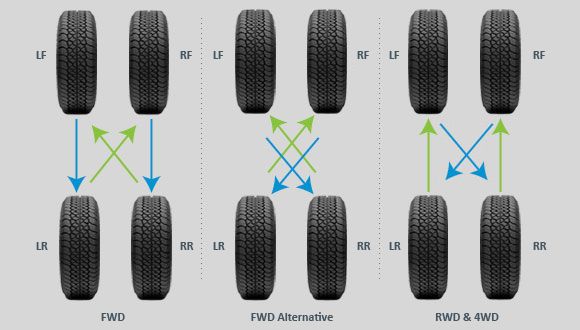 . Let’s take a look at tire rotation patterns recommended by the standardizing body of the tire industry, The Tire and Rim Association, Inc., for all of these possibilities.
. Let’s take a look at tire rotation patterns recommended by the standardizing body of the tire industry, The Tire and Rim Association, Inc., for all of these possibilities.
For vehicles that are 4-wheel, all-wheel, or rear-wheel drive, the rearward cross pattern is recommended. Rear tires are moved to the forward axle and kept on the same side of the vehicle while the front tires are moved to opposite sides of the rear axle.
2. X-PATTERNRecommended for front-wheel drive vehicles such as light-weight trucks and sedans, all tires are moved diagonally, meaning tires are switched from one axle to the opposite as well as being repositioned from one side to the other.
3. FORWARD CROSSThis is the most common pattern for front-wheel drive vehicles. The front axle tires are moved directly back while the rear tires are moved up diagonally to the opposite side of the front axle.
In order to insure that all of the tires on your vehicle have even tread wear, you’ll want to be sure to rotate your full-size spare tire along with the other four. This is especially vital for all-wheel or 4-wheel drive vehicles where even small differences can put undue strain on your car’s drive train.
1. REARWARD CROSS (REAR-WHEEL OR 4-WHEEL DRIVE VEHICLES):Both rear axle tires move directly forward to the front axle while the spare tire moves to the right side of the rear axle. The right front tire moves diagonally back to the left side of the rear axle while the left front tire becomes your new spare tire.
2. FORWARD CROSS (FRONT-WHEEL DRIVE VEHICLES):Rear tires are moved diagonally to opposite sides on the front axle while the right front tire becomes the new spare tire. The spare tire is positioned on the right side of the rear axle while the left tire on the front axle is moved directly back into the left rear position.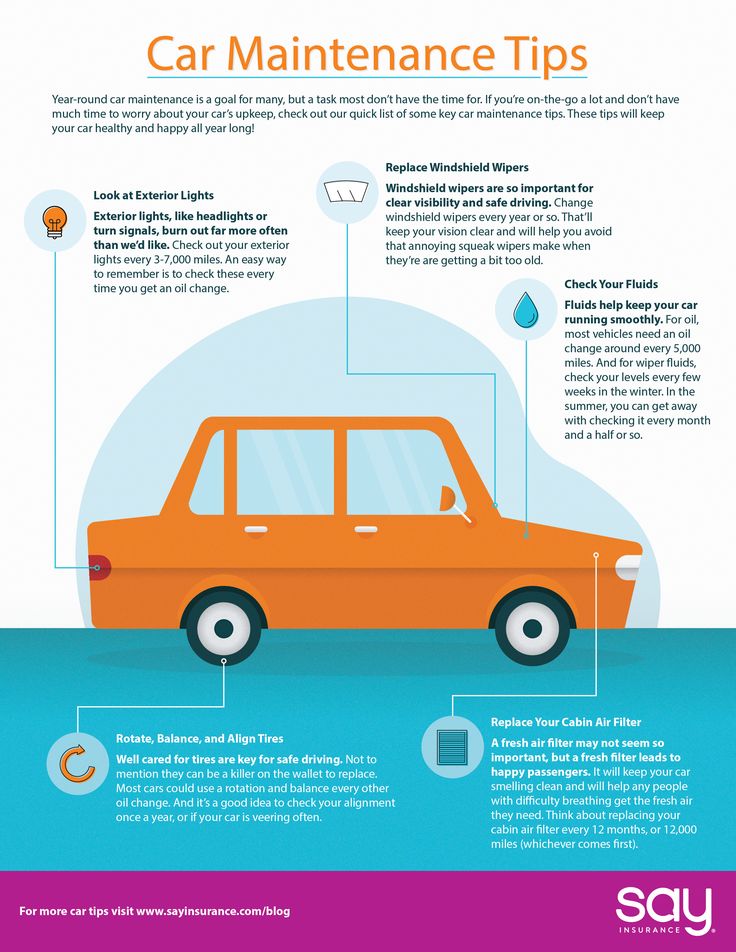
All tires are switched with their same-sized partner and remain on the same axle. The two rear tires switch to the opposite side with one another while the two front tires do the same.
2. FRONT-TO-BACK (FOR DIRECTIONAL TIRES)All tires are moved from one axle to the other but remain on the same side of the vehicle. For example, the front left tire is moved to the left side of the rear axle while the rear left tire is repositioned on the left side of the front axle.
Those with a full size spare tire with a wheel that matches the other four are in luck. The most beneficial tire rotation pattern in my opinion is the 5-tire rotation pattern.
Four tire rotation is great for extending tire life, keeping tread depth even across all tires, and ensuring a smooth and quiet ride.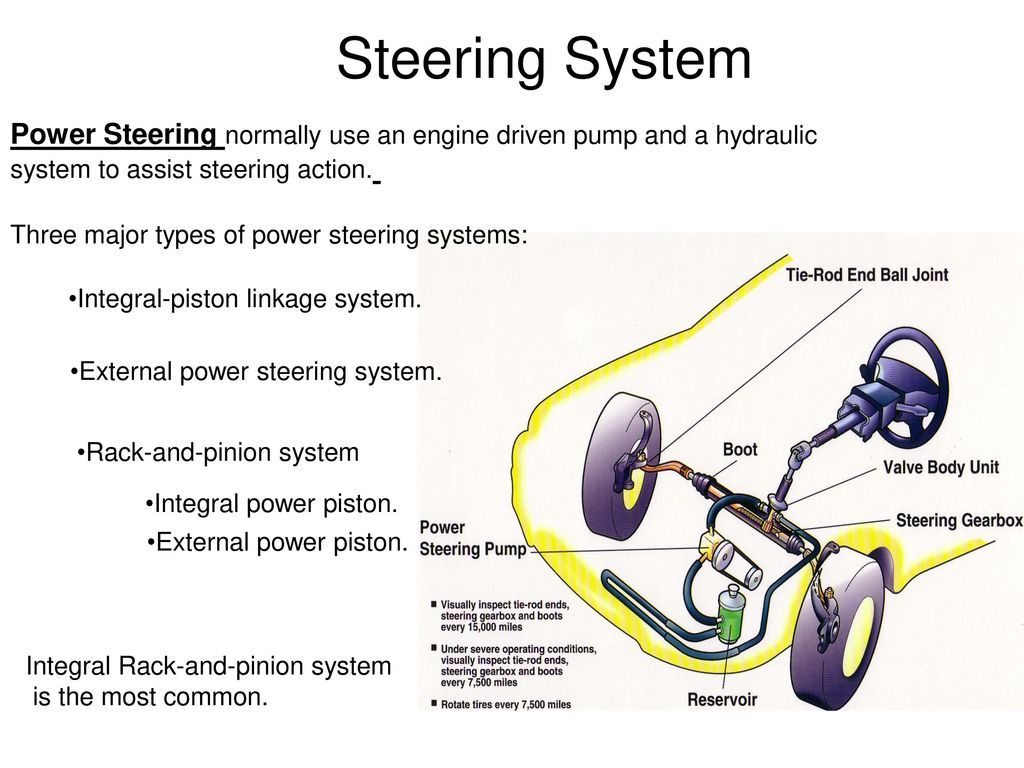 But 5-tire rotation for the luck few that have that full size matching spare has several additional benefits for little extra effort.
But 5-tire rotation for the luck few that have that full size matching spare has several additional benefits for little extra effort.
5-Tire Rotation With Spare Tire
5-tire rotation is performed when a matching full size spare tire and wheel is available. This is common on some trucks and SUVs. A Jeep is a popular vehicle that often has a full size matching spare and can benefit from 5-tire rotation.The 5-tire forward cross or 5-tire rearward cross patterns are the two recommended 5-tire rotation patterns.
Let’s dive into the details of including a spare tire when regularly rotating your tires. We’ll also address some of the more common questions that get asked as well.
Full Size Matching Spare TireThere are only two recommended rotation patterns for including a full size matching spare tire with regular rotations.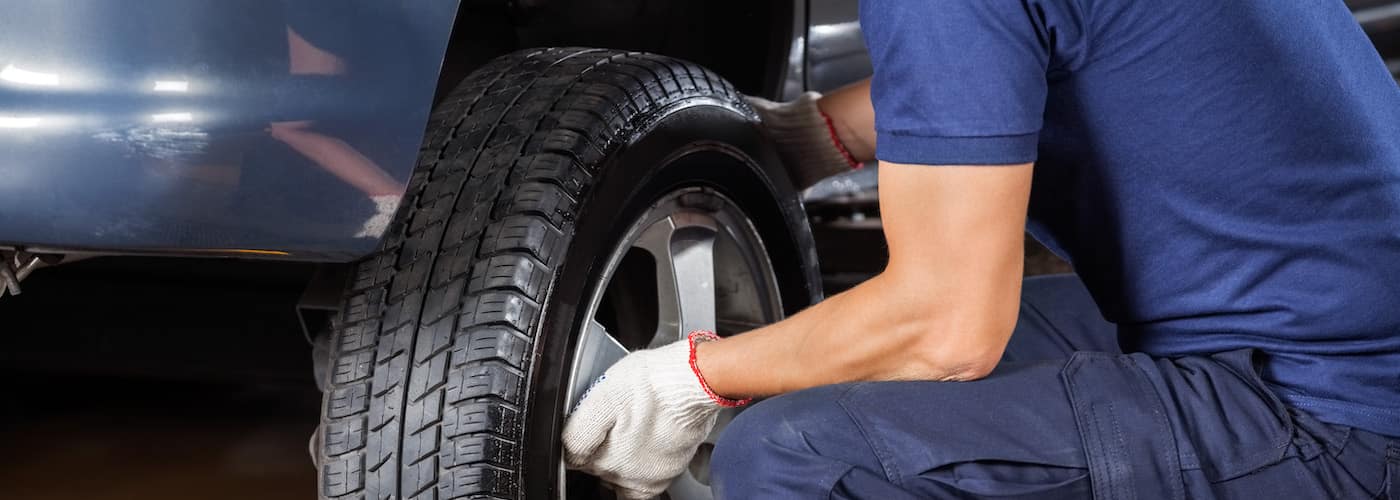 These patterns are dependent upon which axle is the drive axle for the car or truck.
These patterns are dependent upon which axle is the drive axle for the car or truck.
While you’ll likely be fine going with our recommendation based on which axle delivers power to the ground, we still recommend checking your owner’s manual to see if there are any unique requirements or suggestions from your vehicle manufacturer that make affect the best way to rotate your tires.
The 5-tire forward cross is a variation of the popular forward cross that is used on front wheel drive vehicles.
The standard forward cross moves the rear tires forward and across to the opposite sides of the car or truck. The front tires move to the rear axles.
The 5-tire variation on this pattern has a front tire move to the spare tire position and the spare be put into service where the front tire, that was move to the spare location, would have normally rotated.
The 5-tire rearward cross is a variation of the popular rearward cross that is used on rear wheel drive, all wheel drive, and four wheel drive vehicles.
The standard rearward cross moves the front tires rearward and across to the opposite sides of the car or truck. The rear tires move to the front axle.
The 5-tire variation on this pattern has a rear tire move to the spare tire position and the spare be put into service where the rear tire, that was moved to the spare location, would have normally rotated.
The best pattern to use will first and foremost be the one that your vehicle manufacturer recommends. This will almost certainly be the rotation pattern that we recommend based on which axle is used to propel the car or truck forward.
There may be unique requirements with your vehicle so be sure and check your owner’s manual to be sure that you’re making the best choice based on their recommendation.
5-tire rotations are very beneficial for anyone with a full size matching spare tire and require little extra effort to perform.
In fact, using a spare tire when rotating your tires at home yourself can make the job easier. By using the spare, you won’t need to have more than one jack stand and can always have a tire ready to replace the tire that you’re removing.
By using the spare, you won’t need to have more than one jack stand and can always have a tire ready to replace the tire that you’re removing.
Spare tires often get neglected and rarely checked to ensure they’re still able to properly hold air pressure. This is a problem I experienced first hand and I shouldn’t have to tell you that it isn’t a situation you want to be in.
It shouldn’t cost any more to have 5 tires rotated than it would to have only 4 rotated. The extra effort is minimal. Usually, tire rotation is done for free when you’re having other vehicle maintenance services performed.
Even if it isn’t offered for free my your local mechanic, they usually don’t charge much for the service. I do recommend you try to have tire rotation performed while your having some other maintenance task taken care of however. This isn’t necessarily to save money on the cost of the rotation, but to save you time waiting at the shop.
Like with regular 4-tire rotations, rotating tires with a full size spare tire should be done on the schedule required by the tire manufacturer to maintain the tire warranty.
Most tire manufacturers will require proof of regular rotation if you make a tire warranty claim. And they will usually require that the rotations be performed at or before a certain amount of mileage.
The mileage interval you will likely be required to have your tires rotated will usually be between 5,000 and 8,000 miles.
I recommend having rotations performed every 5,000 miles since this will usually meet or exceed the tire manufacturer’s requirement.
5,000 mile rotations will ensure your tires wear evenly or alert you to issues with tire balance, alignment, or suspension problems before the tires have significant uneven wear.
4 tire rotation alone is worthwhile. But including a spare tire into your tire rotation pattern has several great additional benefits:
If I haven’t made it clear, 5-tire rotation is only for cars and trucks that have a full size spare tire and the wheel the spare tire is mounted onto matches the other four wheels on the vehicle.
You shouldn’t perform a 5-tire rotation service with temporary spare tires. The spare tire itself should be identical to the other 4 tires.
While a matching wheel isn’t required, some economy wheels that a full size spare tire may be mounted on could have a different offset or other measurements when compared to the 4 primary wheels and tires. For this reason, I only recommend including a spare in the rotation pattern if all wheels and tires are identical.
A full size spare isn’t always the same as a regular tire. Sometimes the spare is full sized but it is a temporary use tire that is not designed to be used all the time and should only be used in an emergency situation.
If you have a full size spare but it is labeled “Temporary Use” on the side, you shouldn’t include it when you have your regular 4 tires rotated.
If you have a full size spare that isn’t a temporary use tire and is mounted on a matching wheel, it is a very good idea to rotate it along with your other tires.
There are several great benefits of 5-tire rotation if you have a spare wheel and tire that will allow you to do so.
Most tires last only around 6 years before they begin showing signs of dry rot. Spare tires that don’t see use and stay hidden in your trunk or somewhere else where it isn’t as exposed to the harsh weather and sun may last another year or so beyond this before they begin failing.
You can check the age of your tires by checking the DOT code on the sidewall of the tire. The last 4 digits will be the week they were manufactured and the year they were manufactured.
Often, these additional date numbers are only added to the DOT code on one side if the tire. If you don’t see them on the first side you check, look at the other side of the tire to see if they’ve been included there.
Tire rotation is essential for maintaining your tire warranty, but that isn’t the only reason to have rotate tires regularly. Longer tire life, smoother riding and quieter tires, and early detection of tire balance, alignment, and suspension problems are all benefits.
Longer tire life, smoother riding and quieter tires, and early detection of tire balance, alignment, and suspension problems are all benefits.
In addition to these benefits, 5-tire rotation increases the life of the set of tires by 25%. It also ensures that the spare tire gets put to good use before failing due to dry rot.
Including the spare in rotation also helps ensure that it is in good condition and able to properly hold air if an emergency happens and you need to use it.
It’s a shame that not only do most vehicles not come with a full size spare, but many don’t come with one at all these days.
If you’re lucky enough to have a car or truck that has one, be sure and include it when having your tires rotated so you don’t miss out on the benefits.
Below are some links you may find helpful when learning about tires
Will Creech
Will has been an automotive enthusiast since he was old enough to make engine sounds. Formerly a member of the contract training team at Discount Tire, he is unusually knowledgeable on all things related to tires. He is now the owner of and main contributor to TireGrades.com.
Formerly a member of the contract training team at Discount Tire, he is unusually knowledgeable on all things related to tires. He is now the owner of and main contributor to TireGrades.com.
All tires are divided into several types and types. During manufacture, tires are marked with a marking that indicates its main parameters and characteristics. We will not delve into the markings, but we will consider the main differences. Tires are divided into two large groups according to the way the cord is laid inside the tire during its manufacture.
These are radial tires and bias tires. Tires of these two types can be winter, summer and all-weather. Each of these three tires can have a regular or directional tread pattern.
A tire with a regular pattern can be installed on either side of the car, a tire with a directional pattern is installed strictly in the direction of rotation.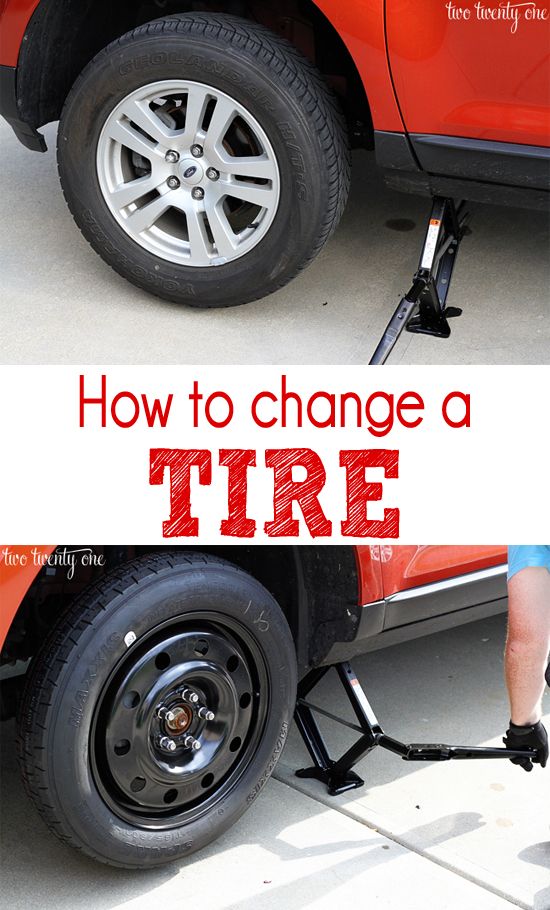 Regular and directional tread patterns can be symmetrical or asymmetrical. A tire with such a pattern is placed according to the rule of a tire with a regular or directional pattern.
Regular and directional tread patterns can be symmetrical or asymmetrical. A tire with such a pattern is placed according to the rule of a tire with a regular or directional pattern.
It is possible to buy 4 identical tires and assemble them with rims according to the right and left sides of the car. You will get two left wheels and two right ones. Very rarely come across directional tires with an asymmetrical pattern and with an indication of the inside and outside. These tires need to buy two on each side. Two right and two left, but it is better to refuse such tires altogether. They are not convenient to use.
Radial tires are preferable for cord construction. Such tires are more reliable, they withstand heavy loads during movement, and are more stable during deformation. Radial tires wear longer than diagonal tires. Therefore, tires with a diagonal ply are currently practically not produced. Almost all car owners have two sets of tires. For the operation of a car in the winter - these are winter tires, for the summer period - summer.
For the operation of a car in the winter - these are winter tires, for the summer period - summer.
All season tires can be used in both summer and winter. Winter tires can be studded. Such tires are allowed only in a few countries, where snow often and abundantly falls in winter, frost forms on the road surface. This list also includes Russia. All-season, summer and winter tires have their own pattern characteristics that increase the car's handling.
Front or rear wheel drive vehicles can be fitted with different tire patterns. Such tires are installed in pairs on one axle, for example, tires with one pattern are in front, and with another in the back. It is forbidden to install diagonal tires on one axle and radial tires on the other. The dimension must be the same. On all-wheel drive vehicles, the same tires must be installed.
Tires with different treads and dimensions are strictly prohibited. This is due to the design of the transmission. If you operate a car with different tires, then the car's transmission will quickly fail. In addition, driving on different tires becomes dangerous, a car on a slippery road will behave unpredictably.
In addition, driving on different tires becomes dangerous, a car on a slippery road will behave unpredictably.
All car and tire manufacturers recommend changing tires while driving. What is it for? During the operation of the car, all tires wear out unevenly. This is due to several factors. Heterogeneity of the road surface, operating conditions and vehicle transmission device. Therefore, in order to extend the life of the tires and the transmission of the car, the tires must be periodically replaced.
On all-wheel drive vehicles, uniform tire wear is more relevant. Car manufacturers recommend several tire rotation schemes. But in practice, as is often the case, it is impossible or impractical to apply such tire swap schemes. Many car owners never swap tires. Which of course is wrong.
How do you change tires and how often should you do it? The frequency is approximately 8 - 12 thousand kilometers. Therefore, tire swapping can be timed to coincide with the change of tires from summer to winter and vice versa. Winter tires can be studded. When using these tires, the studs tilt to one side. This is due to frequent wheel slip.
Winter tires can be studded. When using these tires, the studs tilt to one side. This is due to frequent wheel slip.
Therefore, these tires must be installed in the same direction as they were before. In this case, the tires from the front axle must be put on the rear axle, and the tires from the rear axle should be put on the front axle. In order not to get confused where which wheel was, in a tire shop, the master usually puts a mark on the wheel. If you apply one of the recommended schemes and change the direction of rotation to the opposite when installing the tires, the spikes will begin to tilt in the other direction, their fastening in the tread will weaken and they will start to fly out.
Which, of course, does not justify the expediency of rearranging the tires strictly according to the scheme. There is no point in this, the tires will wear out evenly, but the spikes will almost all fall out. If the tires are not studded, but have a directional pattern, the tires must also be rearranged, from the front axle to the rear, from the rear axle to the front, without changing the installation side on the car.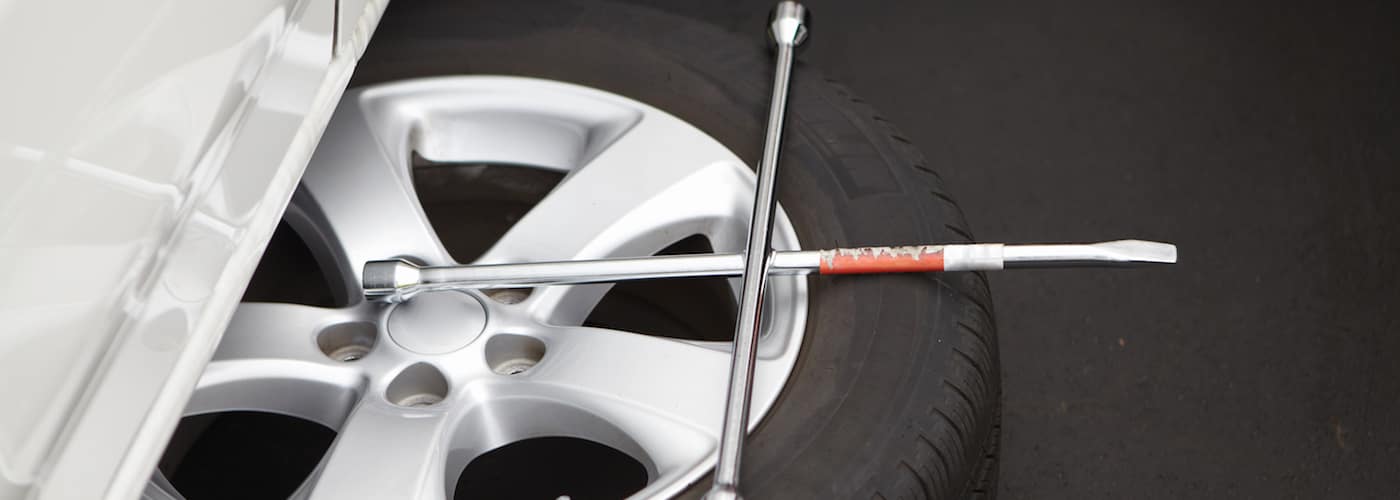 If the tires do not have a direction of rotation, then it is possible to apply a more complex scheme.
If the tires do not have a direction of rotation, then it is possible to apply a more complex scheme.
In this case, the rear tires are moved to the front axle in accordance with the sides. And the front tires are placed on the rear axle, but at the same time the right wheel is placed on the left, and the left wheel is placed on the right. There is another scheme for rearranging wheels. In this scheme, a spare wheel is also involved. The spare must of course be identical. When using such a scheme, the tires wear out a little longer during operation. In this case, the rear tires are rearranged to the front axle without changing sides, the spare wheel is placed on the rear axle on the right, and the right front wheel is placed back on the left. The front left wheel becomes a spare. But such a scheme can be applied if non-studded tires and tires with a non-directional pattern are installed on the car.
If the vehicle is fitted with all-season tyres, it is best to change the tires in the middle of the season. That is, in summer and winter, and not during periods of changing seasons. And it turns out that some wheels constantly "ride" on the snow in front, and the other pair - on asphalt in the summer on the rear axle. Wear will again be uneven. When using a rearrangement scheme without the participation of a spare tire, the latter does not wear out. There is a situation when you have to put a spare tire on the car and drive it.
That is, in summer and winter, and not during periods of changing seasons. And it turns out that some wheels constantly "ride" on the snow in front, and the other pair - on asphalt in the summer on the rear axle. Wear will again be uneven. When using a rearrangement scheme without the participation of a spare tire, the latter does not wear out. There is a situation when you have to put a spare tire on the car and drive it.
The difference between the tread height of the worn tires and the spare wheel adversely affects the vehicle's transmission. But you can still drive several tens of kilometers. It is advisable to drive as short a distance as possible using the spare wheel.
It happens that a car owner has two sets of fully assembled wheels. That is, when replacing tires, you do not need to constantly bead tires. You just need to change the wheels, for example, from winter to summer. Before changing wheels, they must be balanced. Which will also increase their service life, as well as the service life of the car suspension. Many car owners balance their wheels only when replacing tires with new ones and then drive their entire life. It is not right. During tire wear, the point of imbalance changes. During wheel spin, for example in deep snow, the weight on the disc may move. Therefore, it is necessary to balance the wheels periodically.
Many car owners balance their wheels only when replacing tires with new ones and then drive their entire life. It is not right. During tire wear, the point of imbalance changes. During wheel spin, for example in deep snow, the weight on the disc may move. Therefore, it is necessary to balance the wheels periodically.
Contents:
 ..
.. Wheel rotation is like a physical exercise. Everyone knows what to do, but getting yourself to actually do it can be a challenge. While we can't really help you with fitness motivation, we have plenty of good reasons why you should swap tires every 5,000-13,000 miles.
Tire wear is inevitable when using a car. The location and extent of wear on a tire's contact patch depends on many factors, including the position of the tire on the vehicle. Keep in mind that each axle of a vehicle faces a different external force. For example, the front tires on a front wheel drive vehicle are regularly subjected to more intense stress than the rear tires. Thus, front tires on a front wheel drive vehicle typically experience accelerated wear compared to front tires on a rear or all wheel drive vehicle. Changing the wheels helps even out the wear on all four tires. If you leave the front tires uninterleaved on a front wheel drive car, they will wear out faster than the rears.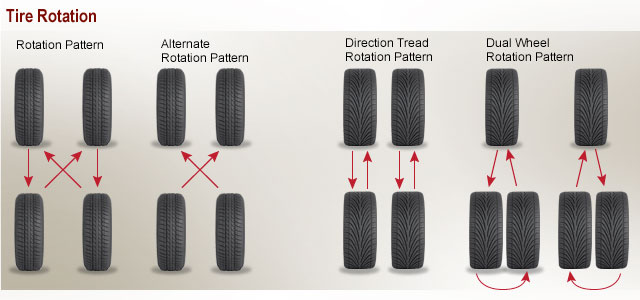 Without a proper check, you will end up with two front tires almost or completely at their maximum tread wear, and two rear tires with life remaining.
Without a proper check, you will end up with two front tires almost or completely at their maximum tread wear, and two rear tires with life remaining.
As a result, you will have to replace some tires prematurely. In some cases, while some of your tires may technically retain their remaining life, it will no longer make sense to pair them with any new tires with unworn tread. So you have to throw away not only worn tires, but also tires with remaining service life!
See also: Tire grip coefficient and factors affecting it
Summarizing all of the above, we can list the main reasons for rearranging tires in places:
Tires are absolutely essential to the efficiency and safety of a car. Keeping your tires in good condition with rotation and other simple maintenance will help keep them wearing evenly which directly affects your vehicle's stability, driving predictability and makes it easier to maneuver safely throughout the life of your tires. Tires in poor condition can cause the vehicle to vibrate.
Tires in poor condition can cause the vehicle to vibrate.
Remember: Uneven tire wear can also affect the stability and handling of your vehicle. Swapping wheels is not only financially sensible, but it also helps to ensure the safety of your driving.
If tires are not rotated and maintained properly, you will likely lose not just a few hundred miles of their life, but thousands. The life of a tire can literally be cut off in the middle if you do not follow the rules for their alternation and do not take other necessary measures for their maintenance.
Tire manufacturers know that rotation is essential to realizing their full tire life. Tire mileage guarantees are most often set by tire manufacturers based on tire rotation. So if you never rotate tires and experience premature tire wear as a result, the manufacturer is unlikely to honor your warranty. In other words, you'll be left on your own with a prematurely worn set of tires and a much more expensive replacement bill.
In other words, you'll be left on your own with a prematurely worn set of tires and a much more expensive replacement bill.
See also: Inflating tires with nitrogen - the pros and cons. What does filling tires with nitrogen give?
The good news is it's inexpensive. That small investment comes back to you in the form of long tire life and sustained vehicle safety and performance. In the long run, the cost of periodic tire rotation will be only a fraction of the amount you have to spend on buying new tires due to premature tire wear. It is also not uncommon for tire shops to offer discounted tire swapping services for regular customers, or from time to time offer to do it for free. So contact the tire shop that installed your tires first - in some cases, your tire rotation costs may be zero.
Helpful Hint: don't forget to label the wheels with the numbers and keep the tire rotation data and receipts.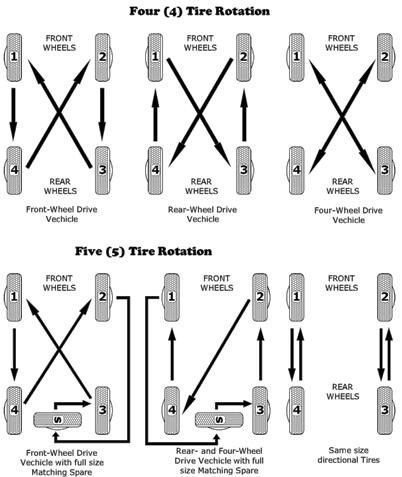 If you ever need to change tires under warranty, having these records will increase your chances of success.
If you ever need to change tires under warranty, having these records will increase your chances of success.
Are you used to doing everything yourself? Then you can rearrange the tires. If you can safely lift the car and remove the wheels, you can change the tires in your garage or on your driveway. In addition to the rearrangement pattern, you need to consider whether your tires are directional or non-directional, symmetrical or asymmetrical, and whether the tire pattern is staggered or square. If you are not sure about at least one of these points, it is better to entrust the work to a professional. Also consider that it is a smart move to leave your tires in the hands of a competent professional from time to time. Tire specialists monitor their potential problems, identify misalignment and other issues that can affect tire condition/wear and vehicle performance.
For non-directional tires of the same size, you can use the diagonal swap pattern or move the front tires to the rear diagonal corner and the rear tires forward on the same side.
Also, due to the availability of modern tires, there is a need for 2 more rotation schemes:
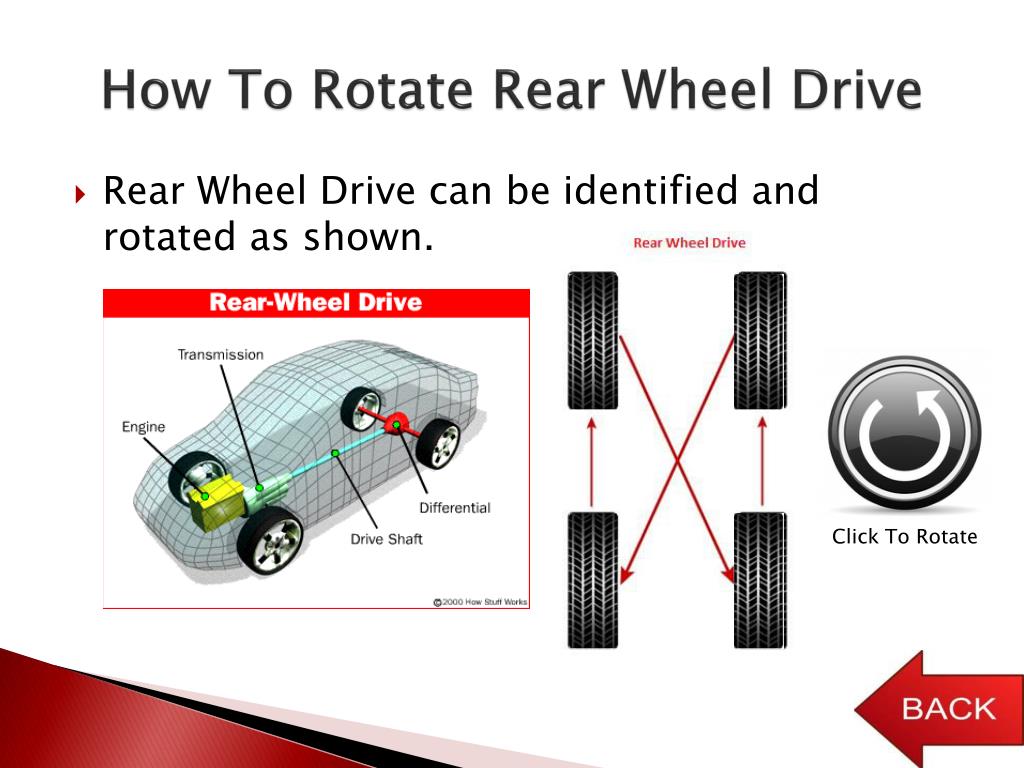 If you have a full-size spare tire, it should also be included in the swap scheme.
If you have a full-size spare tire, it should also be included in the swap scheme. Tire Rotation Chart for RWD and 4WD Vehicles Vehicles with dual rear wheels and non-directional tires may use one of the following rotation patterns:
Winter and studded tires also need to be rearranged so that they serve for a long time and behave adequately on the road.